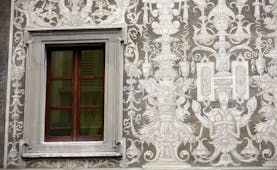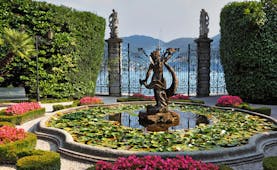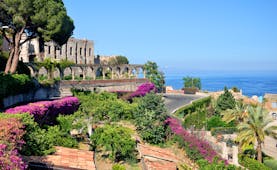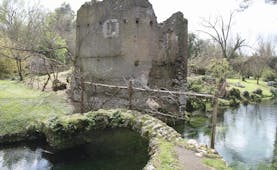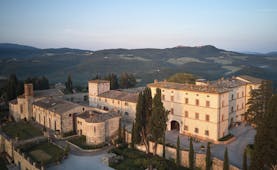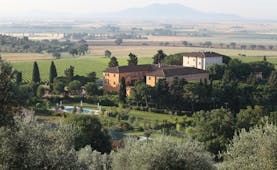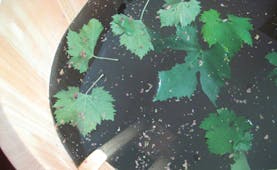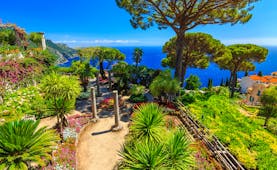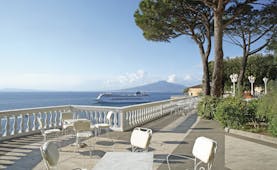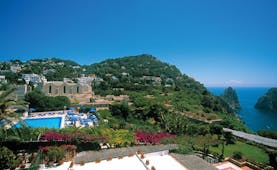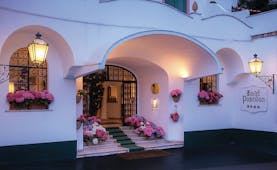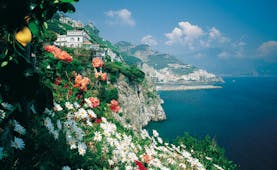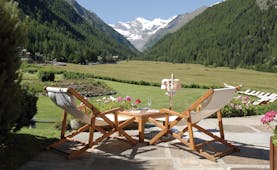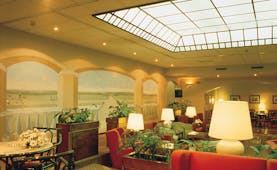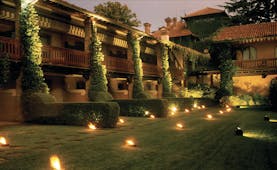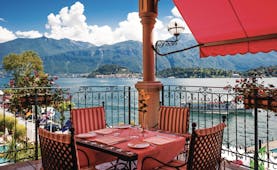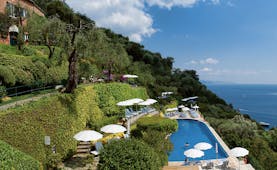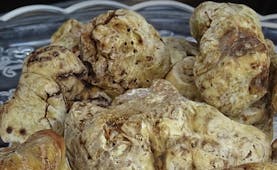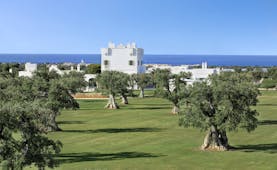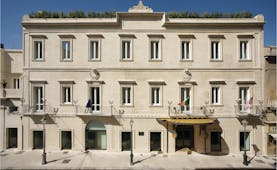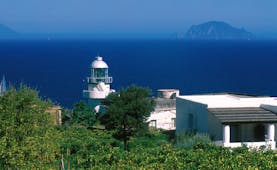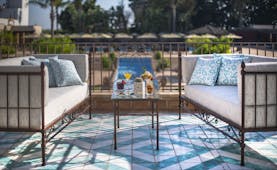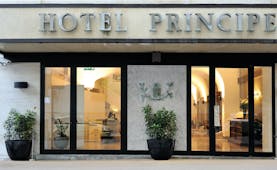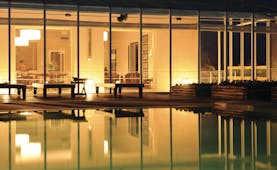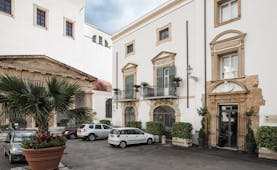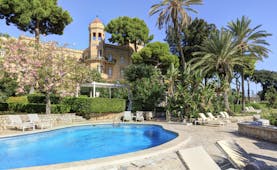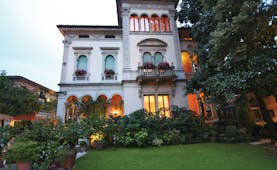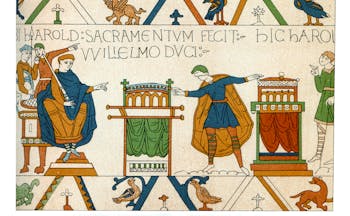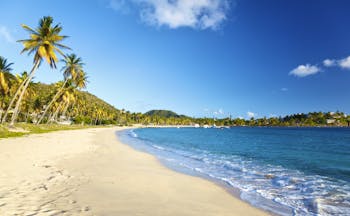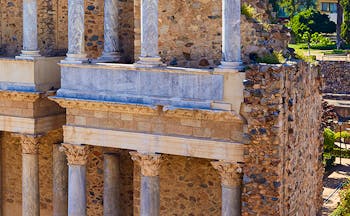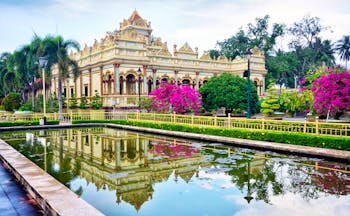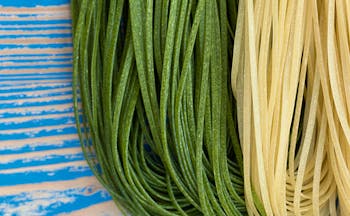Luxury fly-drive tailormade touring holiday from Tuscany to the Alban Hills near Rome
Begin your touring holiday by flying into Pisa where you collect your hire-car. Drive for just over one and a half hours southeast to the heart of the Chianti region of Tuscany. Set just outside the picturesque village of Panzano, the Villa le Barone is a charming four-star hotel with views over the vineyards which stretch into the distance. From here, continue eastwards to the Relais Villa Belpoggio, an intimate boutique hotel set within landscaped gardens. Located in the Chianti Region just north of Arezzo, this private villa-hotel is an excellent base for experiencing rural Tuscany and offers the opportunity to take part in a cookery lesson with the hotel’s chef. Following three nights here, drive about one and a half hours south to the Hotel Palazzo Piccolomini in Orvieto. This small four-star hotel provides a discreet base in the centre of the dramatic Umbrian hill town, located just a few minutes’ walk away from the magnificent Cathedral, considered to be one of the finest in Italy. After staying in Orvieto for one night, travel further south towards your final stop near Frascati. Along your route you can visit two stunning gardens and villas in Tivoli, the Villa d’Este, a UNESCO World Heritage Site which is resplendent in its structure and use of structure; and Villa Adriana, a complex which was built for the Emperor Hadrian and even in its ruined state is one of the most spectacular Roman gardens. From here it is a short drive to Park Hotel Villa Grazioli, a former Cardinal’s villa which has been carefully restored as a four-star hotel combining its history with modern comforts, set in an area which is rich in natural beauty and cultural heritage. You return your hire-car to Rome Fiumicino airport at the end of the holiday for your flight home.
Highlights
Day by day
After arriving in Pisa and collecting your hire car, spend a few hours in the city, taking in the famous historical sights – namely, the Torre Pendente, or ‘leaning tower.’ Aside from the iconic image, Pisa has a lot to offer in the way of culture and history. Take time to visit the Duomo, which dates back to 1064, and the triple-spired Chiesa di Santa Maria della Spina, or explore the Museo Nazionale di San Matteo and its vast collection of medieval artworks. This list is, of course, merely scratching the surface of the inspiring opportunities available in Pisa. From here, begin the drive to Panzano in Chianti, and the Villa le Barone, which will be your hotel for the next three nights. During your stay, we recommend beginning your exploration of the immediate surrounding area on foot or on bike. On your rambles enjoy wine-tastings and tours at local Chianti Classico vineyards. In Panzano specifically you will find a number of establishments open for wine-tasting experiences and vineyard tours. The Accademia del Buon Gusto, for example, is an independent business with a very friendly and accommodating local host offering tastings of wine, olive oil, and even truffled chocolate sauce. The Fattoria Montagliari is best known for its balsamic vinegar, though its wine is also excellent. Or head out into the countryside to villa Vafaggio for a vineyard tour that culminates in a tasting session. A key aspect of your hotel is its convenient location, situated halfway between the cultural city of Florence, and its former rival, Siena. Spend the best part of a day exploring Florence. From the architectural brilliance of the Duomo, the baptistery, the numerous churches and the monastery, which houses a fine selection of Florentine paintings, to Michelangelo’s ‘David,’ now on display in the Accademia, the sights available in Florence are world renowned. If you are spending an evening in Florence, have dinner at the Enoteca Pinchiorri, a double Michelin-starred restaurant serving traditional and experimental Florentine cuisine. Siena, however, is less well-known than Florence, though it remains on a par in terms of outstanding historical monuments and atmosphere. The most impressive spectacle is the incomplete extension to the Duomo di Siena, which was originally commissioned in response to Florence’s own expansion. All that remains is a free-standing archway at the front of the Piazza del Duomo, which would have been the cathedral’s interior, and still has the colourfully tiled floor. On the 2nd of July and 16th August, the Piazza del Campo plays host to a riotous, but atmospheric, medieval tradition. A horseman from each of the 17 districts competes in a horserace around the semi-circular piazza. Nearby San Gimignano is another testament to Italian aspiration. Like Siena, San Gimignano remains incomplete, with the only evidence of its earlier dreams being the many looming towers that rise out of the village squares. Perhaps also take a brief trip into Volterra, a brooding village of tall buildings and exceptionally narrow streets, known for its austere beauty and charm. Many other Chianti villages are within driving distance; such as Certaldo, Colle di Val d’Elsa, with its imposing fortified façade and former moat and drawbridge, and Monteriggioni, a small hilltop hamlet still encased in its original walls, and surrounded by vineyards and olive groves. Of an evening retire to your ivy-covered hotel to indulge in traditional Chianti foods and your luxurious room.
From Panzano, remain in Chianti country but drive on to Loro Ciuffenna, a village that clusters around the gorge of a rocky river, and your hotel, Relais Villa Belpoggio. Loro Ciuffenna was voted one of the most beautiful villages in Italy, and wandering along its irregular streets, it is easy to see why. Cross over the mediaeval single-arched bridge over the ravine, and seek out the two remaining original castle gates, one of which is now the clock tower. Look around the Church of Santa Maria Assunta to see the 14th and 15th century frescoes. Or, drive three minutes out of Loro Ciuffenna to see the Pieve de Gropina, reputed to be the most beautiful Pieve (church with the right to baptise) in Tuscany. Arrange your visit with a tour guide to ensure you can visit the haunting underground Romanesque tombs. One of the crowning glories of Loro Ciuffenna, however, is the lesser-known Mulino ad Acqua, a beautiful old watermill at the bottom of the village. As pretty as something out of a fairy-tale, this mill really captures the spirit of the old village. Drive no more than 45 minutes south to Arezzo and its neighbouring villages, where the Valdarno Valley meets its three neighbours, to see one of Tuscany’s most illustrious areas. Arezzo’s history in gold has made it one of the wealthiest Tuscan towns, and is therefore a centre point for the exploration of magnificent architecture. At the mediaeval Piazza Grande you can sit beside the impressive façade of the Santa Maria della Pieve, with its large bell tower and quadruple layers of grand arches, watching the artists at work in the square and sipping an Italian coffee. Twice a year, this square hosts a large jousting competition, with an atmosphere much like the horserace in Siena, accompanied by costumed parades, numerous competitions and a wealth of exuberant celebrations. Arezzo’s compact layout means that all points of interest can be visited in just a single day, from the mediaeval fortress, the Roman Amphitheatre, and the Church of San Francesco, to the wooden crucifix in the Church of San Domenico. The Duomo San Donato is adorned with original stained glass dating back to mediaeval times. The Duomo itself is an imposing building, grand despite its minimalist exterior detail, with a warm regal charm that suits the Arezzo style. For wine-tasting opportunities, head out into the neighbouring villages. The Villa la Ripa, for example, is a grand private home, surrounded by vineyards that fuel the independent, family business. The Villa offers vineyard tours, tasting sessions, and an opportunity to pick up some aromatic Tuscan souvenirs. To further escape the tourist spots, head into Cortona, Aghiari, or Monterchi on the hunt for the local goat’s cheese or Florentine steak. During your stay here you will have a cookery lesson at the Villa Belpoggio with the chef. Pasta-making is usually on offer.
Continue south on your seventh day, out of hilly Tuscany and onto the jagged volcanic landscape of Orvieto in southwestern Umbria. Orvieto is a surreal settlement that seems to merge with its surrounding landscape, as vertical rocky walls become the walls of the picturesque village houses and the cathedral rises from the centre like a mountain peak. With limited time in Orvieto, it is essential to take a tour of the famous underground city. An ancient network forgotten about until its recent rediscovery, the underground city is comprised of over 1200 caves, as well as wells, rooms, and the remains of an old mill and animal enclosures. Descend into Il Labirinto di Adriano to navigate a smaller network that existed underneath a popular pastry shop and explore the private museum. Above ground, Orvieto has its own beautiful cathedral; much more ornate than the Duomo in Arezzo and with a colourful façade. Or visit the Torre del Moro clock tower, the Etruscan Temple of Belvedere and the necropolis, or the Palazzo del Popolo. Just south of the town are the gardens of Sacro Bosco at Bomarzo, a wooded park with a collection of intriguing and eccentric stone sculptures which date from the 16th century. Your hotel for the night is the elegant Hotel Palazzo Piccolomini, once a noble palace. An alternative is to stay in the Umbrian wine village of Torgiano.
En-route from Orvieto to the Alban Hills, it’s worth making a very slight detour to visit Tivoli where you will find both the villa of the Emperor Hadrian and the grand Villa d’Este, renowned for its magnificent gardens. Your final stay is near Frascati. Taste the delicate local white wines at nearby wineries, go walking in the Alban Hills where charming towns and villages are scattered throughout, or visit the coastal city of Anzio, known as being a landing site during World War II. Also within easy reach are two spectacular yet vastly different gardens – the Giardini della Landriana, an unusual garden which is a mass of colour from April to October, combining luxurious English planting and formal Italian structure; and the Giardino di Ninfa, an amazingly special place with a fantastic collection of plants from all over the world, all of which flourish in the idyllic site. Frascati is one of the hilltop villages that makes up the Castelli Romani, famed for their popularity with Romans seeking fresh air and a break from the city. The most impressive building in Frascati is the Villa Aldobrandini, a palace that seems to dominate the town built for a nephew of the Pope. The main attraction of the town, however, is its relaxed atmosphere and excellent cuisine. The 23rd of June, for example, is the date of the Sagra della Lumaca, an outdoors feast of snails, and in October, Frascati holds the Sagra del Vino, the local wine festival. Another notable residence and gardens to visit is that of the Pope at Castel Gandolfo.
Depending on the time of your flight back from Rome Fiumicino, there may be time for a visit before returning your hire-car to the airport and the flight back to London.
Thank you for planning such an amazing experience for us. We honestly could not have had a better holiday!Mrs E, June 2019
Holiday price guide Prices from £2,595 per person based on two people sharing a double or twin room. Luxury hotel option from £3,880 per person.
Holiday Code ITFD03
Call us on 01392 441245
Luxury fly-drive tailormade touring holiday from Tuscany to the Alban Hills near Rome
After arriving in Pisa and collecting your hire car, spend a few hours in the city, taking in the famous historical sights – namely, the Torre Pendente, or ‘leaning tower.’ Aside from the iconic image, Pisa has a lot to offer in the way of culture and history. Take time to visit the Duomo, which dates back to 1064, and the triple-spired Chiesa di Santa Maria della Spina, or explore the Museo Nazionale di San Matteo and its vast collection of medieval artworks. This list is, of course, merely scratching the surface of the inspiring opportunities available in Pisa. From here, begin the drive to Panzano in Chianti, and the Villa le Barone, which will be your hotel for the next three nights. During your stay, we recommend beginning your exploration of the immediate surrounding area on foot or on bike. On your rambles enjoy wine-tastings and tours at local Chianti Classico vineyards. In Panzano specifically you will find a number of establishments open for wine-tasting experiences and vineyard tours. The Accademia del Buon Gusto, for example, is an independent business with a very friendly and accommodating local host offering tastings of wine, olive oil, and even truffled chocolate sauce. The Fattoria Montagliari is best known for its balsamic vinegar, though its wine is also excellent. Or head out into the countryside to villa Vafaggio for a vineyard tour that culminates in a tasting session. A key aspect of your hotel is its convenient location, situated halfway between the cultural city of Florence, and its former rival, Siena. Spend the best part of a day exploring Florence. From the architectural brilliance of the Duomo, the baptistery, the numerous churches and the monastery, which houses a fine selection of Florentine paintings, to Michelangelo’s ‘David,’ now on display in the Accademia, the sights available in Florence are world renowned. If you are spending an evening in Florence, have dinner at the Enoteca Pinchiorri, a double Michelin-starred restaurant serving traditional and experimental Florentine cuisine. Siena, however, is less well-known than Florence, though it remains on a par in terms of outstanding historical monuments and atmosphere. The most impressive spectacle is the incomplete extension to the Duomo di Siena, which was originally commissioned in response to Florence’s own expansion. All that remains is a free-standing archway at the front of the Piazza del Duomo, which would have been the cathedral’s interior, and still has the colourfully tiled floor. On the 2nd of July and 16th August, the Piazza del Campo plays host to a riotous, but atmospheric, medieval tradition. A horseman from each of the 17 districts competes in a horserace around the semi-circular piazza. Nearby San Gimignano is another testament to Italian aspiration. Like Siena, San Gimignano remains incomplete, with the only evidence of its earlier dreams being the many looming towers that rise out of the village squares. Perhaps also take a brief trip into Volterra, a brooding village of tall buildings and exceptionally narrow streets, known for its austere beauty and charm. Many other Chianti villages are within driving distance; such as Certaldo, Colle di Val d’Elsa, with its imposing fortified façade and former moat and drawbridge, and Monteriggioni, a small hilltop hamlet still encased in its original walls, and surrounded by vineyards and olive groves. Of an evening retire to your ivy-covered hotel to indulge in traditional Chianti foods and your luxurious room.
From Panzano, remain in Chianti country but drive on to Loro Ciuffenna, a village that clusters around the gorge of a rocky river, and your hotel, Relais Villa Belpoggio. Loro Ciuffenna was voted one of the most beautiful villages in Italy, and wandering along its irregular streets, it is easy to see why. Cross over the mediaeval single-arched bridge over the ravine, and seek out the two remaining original castle gates, one of which is now the clock tower. Look around the Church of Santa Maria Assunta to see the 14th and 15th century frescoes. Or, drive three minutes out of Loro Ciuffenna to see the Pieve de Gropina, reputed to be the most beautiful Pieve (church with the right to baptise) in Tuscany. Arrange your visit with a tour guide to ensure you can visit the haunting underground Romanesque tombs. One of the crowning glories of Loro Ciuffenna, however, is the lesser-known Mulino ad Acqua, a beautiful old watermill at the bottom of the village. As pretty as something out of a fairy-tale, this mill really captures the spirit of the old village. Drive no more than 45 minutes south to Arezzo and its neighbouring villages, where the Valdarno Valley meets its three neighbours, to see one of Tuscany’s most illustrious areas. Arezzo’s history in gold has made it one of the wealthiest Tuscan towns, and is therefore a centre point for the exploration of magnificent architecture. At the mediaeval Piazza Grande you can sit beside the impressive façade of the Santa Maria della Pieve, with its large bell tower and quadruple layers of grand arches, watching the artists at work in the square and sipping an Italian coffee. Twice a year, this square hosts a large jousting competition, with an atmosphere much like the horserace in Siena, accompanied by costumed parades, numerous competitions and a wealth of exuberant celebrations. Arezzo’s compact layout means that all points of interest can be visited in just a single day, from the mediaeval fortress, the Roman Amphitheatre, and the Church of San Francesco, to the wooden crucifix in the Church of San Domenico. The Duomo San Donato is adorned with original stained glass dating back to mediaeval times. The Duomo itself is an imposing building, grand despite its minimalist exterior detail, with a warm regal charm that suits the Arezzo style. For wine-tasting opportunities, head out into the neighbouring villages. The Villa la Ripa, for example, is a grand private home, surrounded by vineyards that fuel the independent, family business. The Villa offers vineyard tours, tasting sessions, and an opportunity to pick up some aromatic Tuscan souvenirs. To further escape the tourist spots, head into Cortona, Aghiari, or Monterchi on the hunt for the local goat’s cheese or Florentine steak. During your stay here you will have a cookery lesson at the Villa Belpoggio with the chef. Pasta-making is usually on offer.
Continue south on your seventh day, out of hilly Tuscany and onto the jagged volcanic landscape of Orvieto in southwestern Umbria. Orvieto is a surreal settlement that seems to merge with its surrounding landscape, as vertical rocky walls become the walls of the picturesque village houses and the cathedral rises from the centre like a mountain peak. With limited time in Orvieto, it is essential to take a tour of the famous underground city. An ancient network forgotten about until its recent rediscovery, the underground city is comprised of over 1200 caves, as well as wells, rooms, and the remains of an old mill and animal enclosures. Descend into Il Labirinto di Adriano to navigate a smaller network that existed underneath a popular pastry shop and explore the private museum. Above ground, Orvieto has its own beautiful cathedral; much more ornate than the Duomo in Arezzo and with a colourful façade. Or visit the Torre del Moro clock tower, the Etruscan Temple of Belvedere and the necropolis, or the Palazzo del Popolo. Just south of the town are the gardens of Sacro Bosco at Bomarzo, a wooded park with a collection of intriguing and eccentric stone sculptures which date from the 16th century. Your hotel for the night is the elegant Hotel Palazzo Piccolomini, once a noble palace. An alternative is to stay in the Umbrian wine village of Torgiano.
En-route from Orvieto to the Alban Hills, it’s worth making a very slight detour to visit Tivoli where you will find both the villa of the Emperor Hadrian and the grand Villa d’Este, renowned for its magnificent gardens. Your final stay is near Frascati. Taste the delicate local white wines at nearby wineries, go walking in the Alban Hills where charming towns and villages are scattered throughout, or visit the coastal city of Anzio, known as being a landing site during World War II. Also within easy reach are two spectacular yet vastly different gardens – the Giardini della Landriana, an unusual garden which is a mass of colour from April to October, combining luxurious English planting and formal Italian structure; and the Giardino di Ninfa, an amazingly special place with a fantastic collection of plants from all over the world, all of which flourish in the idyllic site. Frascati is one of the hilltop villages that makes up the Castelli Romani, famed for their popularity with Romans seeking fresh air and a break from the city. The most impressive building in Frascati is the Villa Aldobrandini, a palace that seems to dominate the town built for a nephew of the Pope. The main attraction of the town, however, is its relaxed atmosphere and excellent cuisine. The 23rd of June, for example, is the date of the Sagra della Lumaca, an outdoors feast of snails, and in October, Frascati holds the Sagra del Vino, the local wine festival. Another notable residence and gardens to visit is that of the Pope at Castel Gandolfo.
Depending on the time of your flight back from Rome Fiumicino, there may be time for a visit before returning your hire-car to the airport and the flight back to London.
Thank you for planning such an amazing experience for us. We honestly could not have had a better holiday!Mrs E, June 2019
Holiday price guide Prices from £2,595 per person based on two people sharing a double or twin room. Luxury hotel option from £3,880 per person.
Holiday Code ITFD03
Our prices include
● Flights with British Airways from London Heathrow to Pisa and Rome Fiumicino to London Heathrow
● Hire of a Group B car for the duration of your holiday
● Three nights’ bed and breakfast at the Villa le Barone in Panzano, Chianti or Villa la Massa, Candeli
● Three nights’ bed and breakfast at the Relais Villa Belpoggio, Loro Ciuffenna or Castel Monastero, Chianti Classico
● One night’s bed and breakfast at the Hotel Palazzo Piccolomini, Orvieto
● Three nights’ bed and breakfast at the Park Hotel Villa Grazioli, Frascati
● One cookery lesson per person at Villa Belpoggio
● Scheduled flight with British Airways London to Milan, returning from Venice to London
● Hire of a basic group car for eight days from Milan to Venice
● Private water taxi transfers from Venice Piazzale Roma to hotel and back to airport
Our prices do not include
● Any other services not mentioned above, such as transfers and meals except breakfast at hotels
● Personal holiday insurance. This is essential and cover should be in place from when you book the holiday.
● Local tourist tax, usually between Euros 1 and 3 per person per night, and payable locally to the hotel
Additional information
Driving times for this touring holiday
Pisa airport to Panzano 1 hour 40 minutes
Panzano to Loro Ciuffenna 1 hour 5 minutes
Loro Ciuffenna to Orvieto 1 hour 30 minutes
Orvieto to Frascati 1 hour 30 minutes
Frascati to Rome airport 1 hour
Call us on 01392 441245
Luxury fly-drive tailormade touring holiday from Tuscany to the Alban Hills near Rome

Villa le Barone is an enchanting 4-star hotel in a beautiful rural location in the Chianti countryside. Exquisite gardens, delicious cuisine and excellent wine, alongside authentic, comfortable accommodation, afford guests an intimate, relaxing taste of Tuscany.
Classic double

Villa la Massa is an enchanting 5-star Renaissance villa in the midst of glorious countryside, yet only fifteen minutes from Florence. Gourmet cuisine, stunning grounds and rustic, elegant accommodation afford guests a truly relaxing and restorative retreat.
Deluxe double room

Relais Villa Belpoggio is highly recommended for a charming ambience and high levels of service and comfort. Traditionally Tuscan both inside and out, this hotel also provides guests the opportunity to indulge in authentic Tuscan cuisine.
Standard double

Castel Monastero is a luxurious village-resort with superb facilities. Sympathetically renovated from an ancient hamlet and monastery, this hotel blends original architectural features with excellent cuisine and service in order to create an authentic Tuscan experience.
Superior double room

Hotel Palazzo Piccolomini is an atmospheric 4-star property of exceptional charm located in the heart of Orvieto. The historic architecture and decor of this 15th century building create a welcoming residence, ideal for the exploration of the surrounding region.
Standard double room

Hotel le Tre Vaselle is a 5-star boutique hotel in a beautiful rural location. Wine and gastronomy are at the centre of a stay here. It is superbly located to visit local wineries, and the hotel's spa offers wine-centred treatments.
Premier superior double room

Park Hotel Villa Grazioli is a 4-star, art-filled villa of traditional elegance with wonderful views. Gourmet cuisine, choice of accommodation and park for relxation.
Classic double room in the Paggeria
Thank you for planning such an amazing experience for us. We honestly could not have had a better holiday!Mrs E, June 2019
Holiday price guide Prices from £2,595 per person based on two people sharing a double or twin room. Luxury hotel option from £3,880 per person.
Holiday Code ITFD03
Call us on 01392 441245
Luxury fly-drive tailormade touring holiday from Tuscany to the Alban Hills near Rome
About Tuscany
An Expressions tailor-made holiday in Tuscany allows you to appreciate its classical landscape of rolling hills and vineyards dotted with olive and cypress trees, its misty green-grey mountains that are never too far distant, and hill-top towns of rich brown and gold stone houses. This combines with the beauty of the works of art contained in the towns and villages throughout Tuscany to create an inspirational union of the spirit and the senses. There is an intrinsic comfort in the supposed contrast between the delicacy of a Botticelli and the heartiness of Ribollita soup, yet both are typical of this fascinating region. As birthplace of the Renaissance, the impact of Tuscan and particularly Florentine traditions and culture on European heritage is fundamental to our way of life. In addition to the obvious attractions of the scenery of Chianti and the art cities of Florence and Siena, there are the less well-known regions south of Siena with its moon-like landscape of hills, the patchwork vineyards of Montalcino, the coastal marshlands of the Maremma, the spas of Montecatini and Saturnia, the islands of Elba and Giglio, and the Casentino with the source of the Arno and abundant mushroom crops. Wherever you travel on holiday in Tuscany, you will be inspired by the beauty of your surroundings and the way of life, which is quintessentially that of Italy too.
Highlights of Tuscany
Famous vineyards producing wines of Chianti Classico, Brunello di Montalcino, Vino Nobile di Montepulciano. Alabaster is produced in Volterra. Gold and silver are worked in Florence and the Ponte Vecchio is lined with jewellery shops. Marbled paper and stationery is a speciality of Florence. Ceramics and hand-painted majolica from raw terracotta from Impruneta to the glazed pottery of Siena are to be found throughout Tuscany. Lucca has traditionally produced silk and hand-woven fabrics. Leather goods including shoes, handbags and belts are to be found from market stalls to designer shops such as Gucci and Ferragamo. Interesting markets include the Mercato dell' Antiquariato which sells furniture from antiques to bric-a-brac in Arezzo on the first weekend of every month, in Pisa on the second weekend and in Lucca on the third weekend. The 'wild' Maremma is known for its long-horned white cattle and cowboys (butteri) and natural springs including Saturnia.
Cultural highlights of Tuscany
As birthplace of the Renaissance, Tuscany contains a wealth of treasures: Giotto`s Campanile and Brunelleschi`s Dome in Florence, the Tombs of Galileo and Michelangelo in Florence`s Santa Croce, Botticelli`s `Birth of Venus` and `Primavera` and the portraits of the Duke and Duchess of Urbino by Piero della Francesca in the Uffizi, Michelangelo`s `David` in the Accademia, the architecture of the Piazza della Signoria in Florence, `The Tuscan Maremma` painting by Giovanni Fattori in the Palazzo Pitti in Florence, the Piazza del Campo in Siena, `The Legend of the Cross` frescoes by Piero della Francesco in Arezzo, `The Creation` fresco by Bartolo di Fredi in the Collegiata in San Gimignano, Romanesque church of the Collegiata in San Quirico d`Orcia, 14th Century Fortezza of Montalcino, Renaissance masterpiece of the church of Madonna di San Biagio at Montepulciano, the abbey-church of Sant`Antimo, mediaeval Lucignano and the towers of San Gimignano, the Etruscan Museum in Cortona.
Festivals in Tuscany
Many of Tuscany`s festivals resound with the flamboyance of the Renaissance and keep Tuscans and visitors alike in touch with the region`s rich history. Others are linked to Tuscany`s hearty traditions of eating and drinking. The most famous is Siena`s Palio which takes place on 2 July and 16 August each year. Others include the Sagra del Tordo (Festival of the Thrush) in Montalcino on the last Sunday in October when there is an archery contest and charcoal-grilled thrush are a delicacy. In Florence, Calcio in Costume (a football match played in mediaeval costume) takes place in June. Pisa has the Giocco del Ponte (Game of the Bridge), a mock battle in Renaissance dress also held in June. Viareggio celebrates Carnival on Shrove Tuesday with a huge display of flamboyant floats. In May and August Massa Marittima holds the Falcon Contest.
Gastronomy in Tuscany
Simple country food is at the heart of Tuscan cooking. Regional dishes include Bruschetta (bread or ciabatta toasted and rubbed with garlic, olive oil and salt), Ribollita (bean, cabbage and bread soup), Pasta with hare or wild boar sauce, Porcini mushroom and truffle dishes, Bistecca all Fiorentina (thick cut of sirloin and fillet beef), Cantucci (almond and honey biscuits) served dipped in Vin Santo, Panforte (chocolate, nut and spice cake). Pecorino cheese made from sheep's milk. Local wines include the white Vernaccia di San Gimignano and the Bianco di Pitigliano. Famous reds include Chanti Classico, Brunello di Montalcino and the Vino Nobile di Montepulciano. Vin Santo made from semi-crushed grapes left for several months is an excellent dessert wine.
Call us on 01392 441245
Luxury fly-drive tailormade touring holiday from Tuscany to the Alban Hills near Rome
About Latium
An Expressions tailor-made holiday to Latium holds countless treasures for the visitor. The whole region and its very geography and history produce a wealth of varied scenery and sites. Latium (or Lazio in Italian) lies at the very cultural and historical heart of Italy, with Rome at its centre and is bordered by the Apennine mountains to the east and the Tyrrhenian Sea to the west. A journey through Latium is a journey back to the heart of European civilisation with important Etruscan and Roman remains in evidence throughout the region. Their ancient civilisations are to be found in the obvious and not so obvious places, from temples to stones, from arches to pavements. There are also numerous villas, gardens, abbeys, spas, lakes and hill towns. The countryside is rich and fertile, hilly inland and flat towards the coast. Palms, olives, vines and fruit abound. On the other side of Italy is the little-known region of Abruzzo, rich in beautiful coastline and mountains. It is easily combined with Latium for your holiday and worth visiting for a more off-the-beaten-track region.
Highlights of Latium
There are a number of places nearby that are worth visiting: The hot springs at Tivoli and Fiuggi. The Alban Hills and the 13 hilltop towns surrounded by vineyards and elegant villas of the Roman aristocracy over the years, including the summer palace of the Pope at Castel Gandolfo. Visit mediaeval Anguillara on Lake Bracciano north of Rome. Explore the countryside of the Ciociaria region near Anagni (the name of the region comes from the bark clogs worn by the locals until about twenty years ago). Ostia Antica now inland was once ancient Rome's trading port and the ruins offer a fascinating insight into the Roman way of life. The region north of Rome is very rich in Etruscan remains -visit the necropoli at Tarquinia and Cerveteri. Great monasteries were founded around Rome, especially at Subiaco and Montecassino. The best beaches on the Lazio coast are to be found between Sabaudia and Gaeta. From the town of Bolsena take boat trips to the islands of Bisentina and Martana on Lake Bolseno. Visit the Island of Ponza off the coast near San Felice Circeo.
Cultural highlights of Latium
The gardens of the Villa d`Este at Tivoli. Hadrian`s Villa at Tivoli. Villa Lante near Viterbo. Palazzo Barberini in Palestrina which houses a 1st Century BC mosaic depicting the Nile in flood. The Byzantine frescoes in the crypt of the 11th Century Basilica of Santa Maria in Anagni. The Palazzo Farnese by Vignola at Caprarola. The 13th Century Italian Gothic church of Santa Maria Maggiore at Ferentino. 17th Century frescoes by Domenichino in the chapel at Grottaferrata.
Festivals in Latium
Spring is the main season for festivals in Latium. Genzano holds the `Infiorata`, Marta has the `Barabbata`. In the autumn there is the `Sagra dell`uva` grape festival in Marino. The influence of Rome is obvious in this area, supplemented by either proximity to coast or country.
Gastronomy in Latium
Sage, rosemary and bay are used extensively to season. Specialities of the region include Spaghetti alla carbonara, Suppli (croquettes made with rice, meat and mozzarella), Carciofi alla giudia (artichokes fried crisp in olive oil and sprinkled with lemon juice), Saltimbocca alla romana (veal with ham and sage), Torta di ricotta. Frascati is the best-known white wine of the region although similar wines made from the Trebbiano grape include Colli Albani and Castelli Romani. Very few red wines are produced, but the best is Torre Ercolana.
Call us on 01392 441245
Luxury fly-drive tailormade touring holiday from Tuscany to the Alban Hills near Rome
About Umbria
An Expressions tailor-made holiday to Umbria offers the chance to explore a lesser-known rural area of Italy. Umbria is a gentle, undulating land of hills, river valleys, a patchwork of fields, vines and olives similar in many ways to her better-known neighbour, Tuscany, yet in other ways so very different. Umbria evokes a deeper rusticity, a less ‘polished' feel than Tuscany, the secrecy and mysticism of the Middle Ages and yet because of this holds a charm and fascination for the visitor. The hill towns are superb in their own right; steep, narrow cobbled streets with overhanging arches, the grey stone enlivened here and there by pots of geraniums. Ancient crafts remain very much alive, with ceramics and woodwork in particular. Umbria abounds in Roman architecture with Gubbio and Spoleto being noteworthy and there are Etruscan remains too. The food is hearty and earthy too with truffles and porcini, sausages and salami being regional specialities. Yet Umbria also has some of the most important religious sites in Europe, such as the Basilica of St Francis in Assisi and throughout the region are to be discovered outstanding works of art by Perugino, Giotto, Pinturicchio and Gozzoli. Umbria is an intriguing region that awaits further discovery.
Highlights of Umbria
Shop for ceramics in Gubbio, truffles and cooked meats from Norcia. Dramatic landscapes of the Monte Sibillini and one of Europe's highest waterfalls called the Cascate delle Marmore near Terni. One of Italy's beauty spots is the Fonti del Clitunno south of Trevi. See carpentry and woodworking in Todi. Visit the wine museum in Torgiano. Forests of holm oak near Spoleto. Antique fair in April and a national craft fair in August and September in Todi.
Cultural highlights of Umbria
A mixture of religious and secular art and architecture makes Umbria fascinating. The cities of Perugia and Assisi are great centres but the smaller towns of Gubbio, Todi, Spoleto and Spello are also of outstanding interest. Highlights of the region include the Fontana Maggiore in the Piazza IV Novembre in Perugia. Perugia`s Galleria Nazionale containing works by Perugino and Pinturicchio. Gattapone`s Palazzo dei Consoli in Gubbio and his Ponte delle Torri in Spoleto. The `Adoration of the Magi` by Perugino in the church of the Madonna della Lacrime in Trevi. Frescoes by Matteo da Gualdo in the Pinacoteca of Gualdo Tadino. `San Sebastiano` by Luca Signorelli in the Pinacoteca at Citta di Castello. Frescoes by Giotto and Lorenzetti in the Basilica of St Francis in Assisi.
Festivals in Umbria
Perugia has a jazz festival in the summer and the Sagra Musicale music festival held in its churches in September. Orvieto holds concerts in August and has a firework display on the 15th. Spoleto`s Festival of the Two Worlds, a world-class cultural event, takes place June and July. Spello holds its Infiorata in June when the streets are decked with flowers. Foligno holds jousting in September during its Giostra della Quintane.
Gastronomy in Umbria
Umbria's gastronomy is very much a product of its earth and waters: Mushrooms and truffles flavour many dishes, Game and wild boar, Trevi produces black celery, olive oil and black truffles, Pecorino cheese from Torgiano, Todi offers Panzanella, dried bread soaked and marinated in sliced tomato, basil, onion and olive oil, Sweet macheroni with walnuts, Salami and sausages are a regional speciality, Trout from the rivers and perch from Lake Trasimeno, Strangozzi and Bici are local pasta, often flavoured with porcini and truffles. Umbria produces some high quality robust red wines near Torgiano (Rubesco produced by Lungarotti for example) and Orvieto is known for its white wine.











